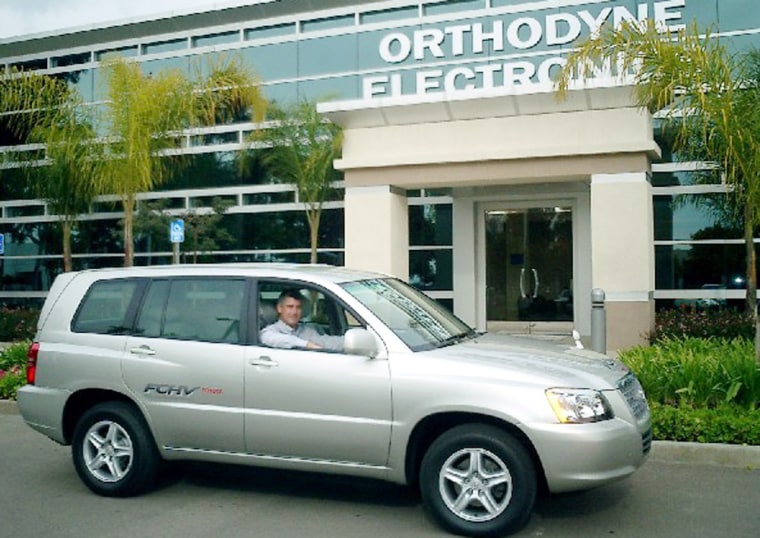Next month, Gregg Kelly will mark his two-year anniversary. For nearly that long, he's been investing part of each day in a committed relationship. Heck, he even keeps a diary.
The relationship is with a machine: a sport utility vehicle that runs on hydrogen and a fuel cell stack, eliminating gasoline and the internal combustion engine. Hydrogen and air pass through the stack, creating electricity to power the car.
Most major carmakers have fuel cell test fleets, particularly in California, but the test drivers tend to come and go. But Kelly is an old-timer who, according to Toyota, has more experience driving test cars than anyone else on the planet.
Seven years ago, the CEO of Orthodyne Electronics had his company lease a plug-in electric car from General Motors. The idea was to allow employees to use the EV1 for errands and even to take turns for home commutes.
GM later discontinued the EV1 but by that time Kelly had volunteered Orthodyne, an Irvine, Calif., company that makes robots for car factory lines, for an all-electric vehicle test by Toyota. Employees shared two tiny electric cars until Toyota swapped those for two larger electric RAV4s, which employees still use.
9,000 miles and counting
Toyota later approached Kelly about becoming a fuel cell test driver, and a modified Toyota Highlander arrived in December 2002. Kelly has been driving it to and from work ever since. It's a short commute, about 10 miles each way, but it's added up to about 9,000 miles.
So what's his take on driving the car? "What's neat is that it drives like a regular Highlander," he says. "It's got plenty of horsepower, you don't have to change driving habits. If there's one feature that stands out it's how quiet it is."

He also likes the fact that he gets to drive alone in California's commuter lanes since the state exempts natural gas and electric cars, fuel cell vehicles falling into the latter category. "That's pretty nice," he concedes.
Kelly's favorite experience has to do with the fact that the only tailpipe emission from fuel cells is water. He was driving the car home the day he got it, he recalls. "My dog was in the driveway and if you turn the car off there's an air compressor that blows air out through the tailpipe to take out moisture. Well my dog, started drinking water out of the tailpipe!"
He immediately called Toyota and was told that while the company doesn't recommend the practice, since metals from the tailpipe could get mixed in with the water, the dog should be fine. Sure enough, no vet was needed, but the dog hasn't been back to the tailpipe since.
Watching his range
Kelly's complaints about the experimental car are its limited range and the lack of a refueling infrastructure, both of which also are problems for plug-in electric cars.
"I do have to be very aware of not taking it out of the area," he says.
The Highlander can go about 120 miles on a tank — that's also typical for fuel cell vehicles, but a third of the range of most gasoline vehicles. Carmakers are stuck in their efforts to compress hydrogen further to get enough to fit the same size tank as is used for gasoline.
Kelly tends to fill up every 60 miles "just because when it gets to half a tank I may not be able to time my next trip" to the refueling station. That station is at the University of California, Irvine — about four miles from his home.
Hydrogen costs vary, but the cheapest is at least twice the cost of gasoline. Under an agreement with UCI, Kelly's company reimburses the university for the hydrogen.
Kelly gives up the car for a few days every couple of months so that Toyota engineers can go over it.
Toyota won't go into details about what it has found, citing proprietary technology and rivals, but spokeswoman Cindy Knight does say "we are seeing somewhat greater-than-anticipated durability" of the fuel cell stack.
A second car for neighborhoods?
Kelly even uses the fuel cell Highlander most weekends, and his daily log reminds him that 90 percent of his trips are under 20 miles.
But he's quick to say that "it's not ready to be my only mode of transportation." He worries about needing to jump in the car for some emergency only to find its tank is half empty. "I'm a little nervous about not having a car I can fill up at a corner station," he says.
Would he buy one of the test cars if they were available for purchase? He's not sure, citing concerns about the lack of a fueling infrastructure and price. Fuel cell stacks are still many times more expensive than an internal combustion engine.
But he has an alternative, near-term vision: using fuel cell vehicles as a second car for an entire neighborhood.
Kelly says he's often asked by people what his prediction is on fuel cells and hydrogen. "They've seen (plug-in) electric cars come and go," he says, "so they're thinking, 'Hydrogen is being talked about, is this really going to happen?'"
He replies that he's no expert, but leaves them with this thought: "There are still a lot of issues, but as gas prices get higher and higher, the justification gets closer and closer."
